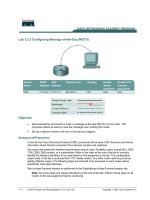Tài liệu Developing Regional Bond Markets In East Asia: The Way Forward ppt
Bạn đang xem bản rút gọn của tài liệu. Xem và tải ngay bản đầy đủ của tài liệu tại đây (131.75 KB, 5 trang )
Developing Regional Bond Markets
In East Asia: The Way Forward
1
Introduction
The Asian financial crisis of 1997-1998
has triggered intense efforts to promote
regional monetary and financial
cooperation to prevent recurrence of
future crises. Recently, developing
regional bond markets in East Asia has
emerged as one of the key agenda for
regional financial cooperation. There is
no assurance, however, that the proposed
regional bond markets will ever leave the
drawing board. Even if they do, they may
never reach the maturity to be competitive
vis-à-vis global bond markets in North
America and Europe. A few critical
issues arise from this perspective:
- If regional bond markets are to be
created in East Asia, would they be
viable? What is the economic
rationale for the creation of regional
bond markets in East Asia?
- What would be the structure and
characteristics of these markets, if
they are to be designed to serve the
needs of both borrowers and
investors in East Asia?
- How could these markets be
organized? Would they emerge in
the course of economic integration
that has become deeper in recent
years? If not, should East Asian
governments make joint efforts to
build the necessary institutional
infrastructures and harmonize their
financial and other standards as
well as tax treatments?
The PECC Finance Forum undertook a
study of these issues in 2003 and
discussed the findings from this study at
its 2nd Annual Conference held in Hua
Hin, Thailand, on July 8-9. The present
report summarizes the outcome of this
discussion in terms of the rationale, the
strategy, as well as the roadmap, for the
creation of Asian bond markets.
What are the Asian bonds?
Asian bonds share three common factors;
Asian issuers, Asian investors and Asian
currencies. Asian bonds are issued by
Asian entities including governments,
government agencies and corporations.
They are denominated in Asian
currencies. They will be purchased by
Asian investors as well as by global
investors.
Rationale and Strategy
Developing regional bond markets in East
Asia enhances global financial stability
as well as regional financial stability. The
double mismatches, the maturity
mismatch and the currency mismatch, can
be overcome by developing Asian bond
markets where regional issuers can raise
2
funds with longer maturities and in local
currencies. Developing bond markets in
the regional level as well as the domestic
level reduces over-reliance on bank
financing, which has been pointed by
many as the main culprit of the Asian
financial crisis. In addition, Asian bond
markets provide Asian investors with
opportunities to invest in the region. With
the information advantage enjoyed by
regional investors, deeper capital market
integration in East Asia enhances the
financial stability of the region.
The aforementioned problems including
the double mismatches, over-reliance on
bank financing and lack of regional
mobilization of savings can be resolved
if a country has sound and efficient
domestic bond markets in which foreign
investors and issuers actively participate.
The reality is that, in many East Asian
economies, domestic bond markets are at
the nascent stage of development. It will
take much time and resource to develop
the market infrastructure required of
efficient bond markets. Some economies
simply do not have the economic size to
bear the burden of developing such a
market infrastructure. Issuers in these
economies should rely on cross-borer
issuance for long-term bond financing.
Global bond markets provide issuers with
alternatives to regional bond markets for
cross-border bond financing. The global
financial centers with well-established
exchanges and over-the-counter markets
and clearing and settlement systems
provide a cost-efficient way of cross
border financing. The reality, however, is
that most of the East Asian borrowers sub-
investment grade issuers. They cannot
issue bonds on their own credit.
Various financial schemes and products
including securitization, credit
guarantees, currency basket bonds, and
Asian bond banks can be employed to
develop Asian bond markets.
Securitization can help issuers overcome
the credit/maturity mismatch with
reasonable cost by allowing them to
create securities whose risk profile is
tailored to the risk preference of the
investors. Credit guarantees are also
useful in further reducing the credit
quality gap. Oh and Park (2003)
1
. propose
establishment of regional credit guarantee
facilities to supply credit insurance that
suits the need of East Asian issuers. Rhee
and Stone (2003) propose that credit
enhancement can be achieved by adopting
the idea of municipal bond banks. Asian
bond banks can reap the benefit of credit-
rating arbitrage and the economies of
1
Gyutaeg Oh and Jaeha Park, “Fostering Asian Bond Markets Using Securitization and Credit Guarantee.” material
presented at the Voluntary Working Group Meeting of the Asian Bond Market Initiative, June 16, 2003,Tokyo
3
scale by pooling the funding needs of
Asian borrowers.
Currency basket bonds can be useful in
overcoming the currency mismatch
problem if their risk-return profile can
secure demand from investors. For
example, the ABC bonds proposed by Ito
(2003) distribute cash flows from pledged
bonds with local currency denomination
on a pro rata basis to the holders.
On the demand side, the Asian Bond Fund
launched by the EMEAP will invest in
dollar denominated bonds issued by
Asian sovereign and quasi-sovereign
issuers. In order to resolve the currency
mismatch problem, however, an
extension of ABF need to be established
to include bonds denominated in Asian
currencies in the portfolio.
There are plenty of reasons to believe that
the proposed financial schemes can
achieve the goal of creating Asian bond
markets and resolving the double
mismatches. There are, however, reasons
to doubt if these schemes are capable of
accomplishing their tasks as pointed out
in Park and Park (2003) and Tran and
Roldos (2003). We cannot take it for
granted that adoption of these schemes
will automatically resolve the double
mismatches. It is because there is no free
lunch in the financial market. These
schemes have to be examined carefully
for their commercial viability.
Roadmap
It is desirable that development of
regional bond markets be a market-driven
evolutionary process where countries
aspiring to become regional financial
centers compete with each other to
enhance their market efficiency. Still,
there is room for cooperation among
governments but it should be confined to
development of financial, legal and
regulatory infrastructure at the regional
level to ensure efficiency of regional bond
markets. Once the infrastructure is in
place, promotion of regional bond
markets should be left to the private
participants.
While various financial schemes
proposed will turn out to be useful in
creating supply and demand for Asian
bond markets, a large number of market-
supporting institutions should be created
to ensure stability and efficiency. They
are: regional credit rating agencies, credit
enhancement and guarantee agencies,
clearing and settlement system, a central
securities depository, cross-border
securities borrowing and lending
mechanisms, and exchange and over-the-
counter markets for bond trading. In
addition, existing barriers to efficient
4
cross-border trading and settlement in
East Asia including national differences
in technical requirements, market
practices, tax and legal procedures should
be identified and properly addressed.
While promoting regional bond markets,
continuous efforts should also be made
to develop sound and efficient domestic
bond markets. The double mismatch
problem can be best overcome by
domestic financial reforms to enhance
efficiency and transparency of domestic
financial markets. Institutional reforms to
garner investor protection are also in
As part of the study done by the PECC Finance Forum, the following papers were
presented at the 2nd Annual Conference of the Forum held in Hua Hin on July 8-9,
2003:
Ho, Richard Yan Ki and Chak Sham Michael Wong, “Road Map for Building the
Institutional Foundation for Regional Bond Market in East Asia
Ito, Takatoshi, “The ABC of ABC bonds”
Park, Yung-Chul and Daekeun Park, “Creating Regional Bond Markets in East Asia:
Rationale and Strategy”
Rhee, S. Ghon, “The Structure and Characteristics of East Asian Bond Markets”
The following papers were submitted to the Conference as background materials:
Rhee, S. Ghon and Gregory R. Stone (2003), “The Asian Bond Bank: A Good Idea to
Explore for Credit Enhancement”
Tran, Hung Q. and Jorge Roldos (2003), “Asian Bond Markets: The Role of
Securitization and Credit Guarantees”
These papers are all available on-line at />order. Without domestic financial reforms
to increase supply of investment grade
financial products and to enhance market
efficiency, regional bond markets cannot
be a success. Regional bond markets
cannot be a replacement for domestic
financial reform.
Regional bond markets should be
developed as an integrated part of the
global capital market. The governments
hoping to create regional financial centers
in their economies should be ready to
open up their domestic financial markets
to foreign investors, foreign issuers and
foreign financial intermediaries.









